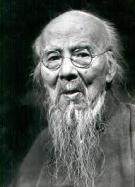| What is the life story of Qi Baishi? Qi Baishi was a famous painter whose life of nearly 100 years spanned two centuries. In 1864 Qi Baishi was born in Hunan, his former first name is Chunzhi, and was called Weiqing. It was later changed to Huang, whose alternative names were Baishi and Scholar Mu. He was a professor of the Central Academy of Fine Arts. In his youth, he learned flower engraving carpentry, and began to learn painting in 1888. He was the leader of the Long Shoushan Poem Community. Starting in 1902, he traveled to Shanxi, Beijing, Jiangxi, Guangdong and Guangxi five times. In 1917 he went to Beijing for the second time, and settled down there in 1919 when
| 
|
he began to reform his artistic style. From 1926 to 1936, he was appointed to teach in the National Beiping Art School. In 1937, he decided to add two years to his age. In 1946, he held exhibitions in Nanjing and Shanghai and was appointed as an honorary professor of the National Beiping Art School. In 1949 Qi Baishi was selected as a member of the All-China Federation of Literary and Art Circles and the All-China Artists' Federation. In 1952 he was appointed as an honorary professor of Central Academy of Fine Arts, chairman of Union of Chinese Artists, research fellow of Central Research Institute of Culture and History, chairman of Beijing Traditional Chinese Painting Research Association, honorary director of Beijing Institute of Traditional Chinese Painting. In 1953, the Ministry of Culture awarded him the title "People's Artist". In 1955, German Institute of Art and Science awarded him "Communication Academician". In 1963, he was selected as one of the world's cultural celebrities by the World Peace Council. And in the same year, a memorial exhibition for the 100 Year Anniversary of his birth was held in China Art Gallery. At the same place his 120 Year Anniversary Exhibition was held in 1983. Some albums like "Selected Works of Qi Baishi", and "Selected Works of Qi Baishi Landscape Paintings" have been published. |